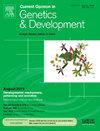利用全面的基因组比较将表型与基因型联系起来
IF 3.6
2区 生物学
Q2 CELL BIOLOGY
引用次数: 0
摘要
比较基因组学是阐明宏观进化时间尺度上表型多样性的遗传基础的有力方法。测序、基因组组装、注释和比较方法的最新进展促进了大规模分析,揭示了基因组决定因素在认知、代谢、身体计划以及与生物医学相关的表型(如抗癌、长寿和病毒耐受性)方面的差异。这些研究强调了多种分子机制的共同作用,并指出基因和增强子损失在驱动表型变化中的作用尚未得到充分认识。然而,挑战依然存在,包括全面的表型数据库和基因组注释、鉴定谱系特异性适应的改进方法以及功能测试。在这里,我们回顾了最近的进展,重点介绍了主要发现,并讨论了使用比较基因组学将表型与基因型联系起来的未来方向。本文章由计算机程序翻译,如有差异,请以英文原文为准。
Linking phenotype to genotype using comprehensive genomic comparisons
Comparative genomics is a powerful approach to illuminate the genetic basis of phenotypic diversity across macro-evolutionary timescales. Recent advances in sequencing, genome assembly, annotation, and comparative methods promoted large-scale analyses that unveiled genomic determinants contributing to differences in cognition, metabolism, and body plans as well as phenotypes with biomedical relevance, such as cancer resistance, longevity, and viral tolerance. These studies highlight joint contributions of multiple molecular mechanisms and indicate an underappreciated role for gene and enhancer losses driving phenotypic change. However, challenges remain, including comprehensive phenotype databases and genome annotations, improved approaches for identifying lineage-specific adaptations, and functional tests. Here, we review recent progress, highlight major discoveries, and discuss future directions for linking phenotype to genotype using comparative genomics.
求助全文
通过发布文献求助,成功后即可免费获取论文全文。
去求助
来源期刊
CiteScore
7.90
自引率
0.00%
发文量
102
审稿时长
1 months
期刊介绍:
Current Opinion in Genetics and Development aims to stimulate scientifically grounded, interdisciplinary, multi-scale debate and exchange of ideas. It contains polished, concise and timely reviews and opinions, with particular emphasis on those articles published in the past two years. In addition to describing recent trends, the authors are encouraged to give their subjective opinion of the topics discussed.
In Current Opinion in Genetics and Development we help the reader by providing in a systematic manner:
1. The views of experts on current advances in their field in a clear and readable form.
2. Evaluations of the most interesting papers, annotated by experts, from the great wealth of original publications.[...]
The subject of Genetics and Development is divided into six themed sections, each of which is reviewed once a year:
• Cancer Genomics
• Genome Architecture and Expression
• Molecular and genetic basis of disease
• Developmental mechanisms, patterning and evolution
• Cell reprogramming, regeneration and repair
• Genetics of Human Origin / Evolutionary genetics (alternate years)

 求助内容:
求助内容: 应助结果提醒方式:
应助结果提醒方式:


